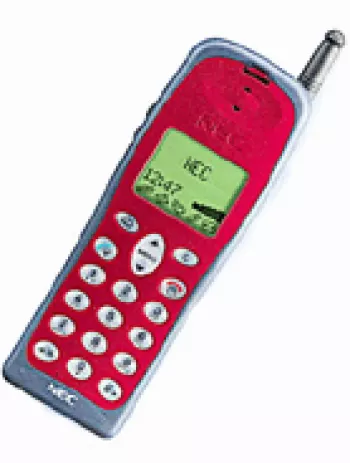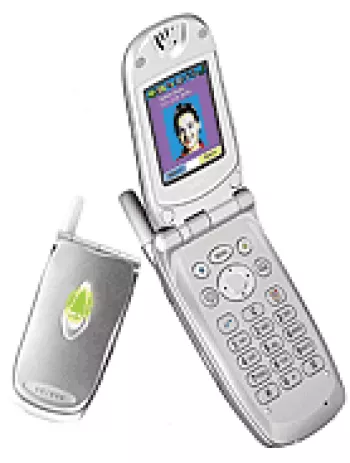
Design and Build
The NEC e808y, released in 2003, exhibits a distinctive design that was quite unique for its time. With dimensions measuring 143 x 75 x 20 mm, its relatively large size was dictated by the inclusion of a full QWERTY keyboard, a rare feature in mobile phones back then. This keyboard was intended to facilitate easier texting and emailing, which were beginning to gain popularity. Weighing in at 190 grams, it was somewhat hefty, adding to its substantial feel. This weight, combined with its form factor, made it noticeable in a pocket or handbag. The use of a Mini-SIM card was standard for that era, connecting users seamlessly to GSM and UMTS networks.
Display
The device sported a TFT display capable of showing 65K colors, which was quite vibrant for the time. Although the screen's size isn't explicitly specified, its resolution of 132 x 160 pixels fit approximately 8 lines of text, making it functional for basic tasks like reading messages or browsing through contact lists. This display, while not particularly advanced by today’s standards, was in line with the feature phone capabilities of its time, focusing more on practicality than high-resolution visuals.
Camera
Equipped with a CIF rear camera, the NEC e808y allowed users to capture photos and record videos, albeit at basic quality given the 0.1MP specification. This was more of a novelty rather than a feature for serious photography. Still, the inclusion of both a main camera and the ability to shoot videos signified an early adoption of multimedia capabilities, setting a foundation for more advanced features in future generations of mobile devices.
Memory and Storage
The internal storage capacity of the NEC e808y was 64MB, a limited amount compared to modern standards. Importantly, the phone did not support expandable storage via card slots, which restricted users to the onboard memory for storing contacts, messages, and multimedia files. This constraint meant that users had to judiciously manage their data, a challenge quite typical of early 2000s mobile devices. The phone's ability to store up to 500 contact entries with photo call integration was a notable feature, enhancing its functionality as a communications device.
Network and Connectivity
Supporting GSM 900/1800 and UMTS 2100 bands, the NEC e808y provided connectivity options suitable for its release period. The presence of 3G connectivity, allowing speeds up to 384 kbps, was a significant advancement, as many competing devices at the time were still reliant on slower 2G network speeds. However, the absence of Bluetooth, WLAN, or a 3.5mm audio jack showed that wired and short-range wireless options were limited, typical of phones from this era. An intriguing inclusion was the proprietary USB connection, which facilitated data transfer and charging, albeit within the confines of NEC's ecosystem.
Operating System and Interface
Operating as a feature phone, the NEC e808y was designed with essential functionality in mind, forgoing advanced smartphone operating systems like those found in later models. Its primary interface was straightforward yet functional, supporting SMS, EMS, MMS, and Email for messaging. The phone also featured a WAP browser, accommodating light web browsing. While not capable of running modern apps, it supported Java, allowing users to run basic games and applications, enhancing the device’s functionality for users seeking entertainment or productivity tools.
Battery Life
The removable Li-Ion battery in the NEC e808y provided adequate power for typical use, with up to 70 hours of standby time and 3 hours of continuous talk time. This was sufficient for daily use, reinforcing its reliability as a communications tool. The ability to easily replace the battery added to the phone's practicality, allowing users to contact support or purchase a spare battery when necessary.
Sound and Multimedia
Sound capabilities of the NEC e808y were modest, featuring downloadable polyphonic ringtones and the ability to alert users via vibration. However, it lacked a loudspeaker, and without a 3.5mm jack, users had limited options for private listening. This limitation also extended to its multimedia capabilities, where audio playback was not a primary focus, in contrast to later developments where music and multimedia would become key features in mobile devices.
Miscellaneous Features
A variety of other features contributed to the usability of the NEC e808y. It included essentials like clock and alarm functions and even a few games to keep users entertained. Available in two colors—Gold and Black—the phone offered a limited but appreciated range of customization options. These attributes combined to provide a well-rounded user experience that balanced business and entertainment requirements, even if in basic forms.
Conclusion
The NEC e808y represented a confluence of design and technology prevalent in the early 2000s. While it may seem rudimentary compared to modern smartphones, it was a pioneering model that encapsulated the transition from basic mobile phones to more sophisticated communication and multimedia devices. The inclusion of a QWERTY keyboard, color display, and supportive messaging capabilities underscored its role as a multifunctional device. Despite its limitations in memory and connectivity, it set the stage for future innovations and remains a testament to the rapid evolution witnessed in mobile communication technology.
Key Features of NEC e808y
- Supports GSM/UMTS networks for extended compatibility.
- Equipped with a QWERTY keyboard, facilitating easier typing.
- Offers a color TFT display with 65K colors.
- Supports photo call with a phonebook capacity of 500 entries.
- Main CIF camera with video recording capability.
- Selfie camera included for video calls.
- Messaging capabilities include SMS, EMS, MMS, and Email.
- Java support for running applications and games.
- Removable Li-Ion battery with up to 70 hours standby time.
- Available in two colors: Gold and Black.
NEC e808y Main Drawbacks
- Lacks compatibility with modern networks (GSM/UMTS only).
- Discontinued status, making parts and support hard to find.
- Bulky and heavy design (190g).
- Low resolution display (132 x 160 pixels).
- No expandable memory; limited to 64 MB internal storage.
- No loudspeaker and 3.5mm jack for audio output.
- Limited connectivity options: No WLAN, Bluetooth, GPS or Radio.
- Proprietary USB port limits compatibility with standard accessories.
- Very limited battery life (up to 70 hours standby and 3 hours talk time).

View Also
More Phones
All Rights Reserved +14266 Phones © Mobilawy 2025

























